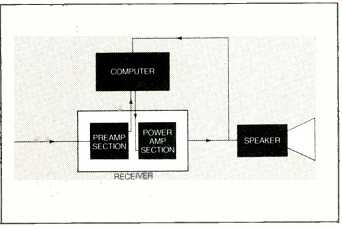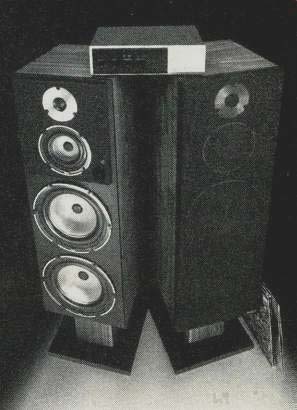How to get an honest 30Hz from a 1.25 cubic foot speaker system.
The story behind the new KLH Computer Controlled Loudspeakers.
With the introduction of acoustic suspension more than 20 years ago, the loudspeaker industry took an impressive step forward. This technology allowed speaker manufacturers to achieve full-range frequency response in a cabinet substantially smaller than any previous full-range loudspeaker.

Since then, breakthroughs have come and gone in the industry. But none that has significantly reduced the size of a true, full-range system.
The reason is actually quite simple. Accurate bass reproduction requires a woofer to displace a large volume of air. In a small system with a small woofer, the woofer cone must therefore travel a long way to reproduce the lower frequencies.
Although a small woofer is perfectly adequate most of the time, occasional high level, low frequency signals can drive the cone well beyond its intended excursion, causing severe over load distortion.
To avoid this, it has been necessary to attenuate lower frequencies in smaller systems. Which is why small speakers have always had compromised bass.
The KLH Analog Bass Computer.
To solve this problem, we developed a completely new approach-computer control. We designed a separate component, the KLH Analog Bass Computer, as an integral part of the entire speaker system. This component sits next to the receiver or amplifier and constantly monitors its output. The computer derives an electronic analog of cone motion, and controls the woofer at the precise instant at which overload distortion would otherwise occur.
With this kind of accurate, reliable control, our designers were free to extract the optimum theoretical performance for any given cabinet size. And develop a line of loudspeakers that can deliver extended bass response in cabinets that are substantially smaller than ever before possible.
The KLH-1 is one example.
From a 1.25 cubic foot cabinet, it delivers bass to 30 Hz (-3dB) at 105 dB s.p.l. with absolutely no possibility of overload distortion.
Beyond the Computer.
Since the Analog Bass Computer and the speakers must be designed as a single, integrated system, we started from scratch with the objective of optimizing our new technology.
To achieve the widest possible bandwidth with acceptable efficiency, we employed sixth-order equalized systems. Combined with the Analog Bass Computer, these systems provide a -3dB point equal to conventional acoustic suspension systems of at least four times their volume.
In keeping with our objectives, we also refused to compromise other elements of the design.
For our cones, we selected polypropylene, a material first developed for use in studio monitors by BBC engineers. The movement of polypropylene reflects the electrical signal more faithfully than either paper or bextrene. The result is a remarkably clear, transparent, uncolored midrange.
For our speaker baskets, we used die-cast aluminum rather than stamped steel. And we used massive magnet assemblies, optimized for the sixth-order design.

above: The new KLH-1 with Analog Bass Computer
Three Applications.
Finally, we applied all we had learned to accomplish three distinct objectives.
Our first objective was to produce a speaker that raises the absolute level of low-frequency response in a cabinet that is still practical for the home environment. The new KLH-1 does exactly that. It delivers flat bass to 30 Hz (-3dB) from a floor standing unit just 11" x 30 1/2" x 10 1/4". At a price per pair of $1100** including Analog Bass Computer.
Our second objective was to provide the best possible combination of price and performance. Our solution is the KLH-2. At $660** per pair with computer, the KLH-2 can deliver flat bass to 38 Hz (-3dB) at 102 dB s.p.l. from a cabinet that measures 10¼” x 21" x 8 1/2".
Our third and final objective was to design a moderately priced speaker with performance equal to or better than anything near the cost, in a cabinet one fourth the size. This is the KLH-3. It measures 8 1/2" x 12 1/2" x 6". delivers bass to 40 Hz (-3dB) at 95 dB s.p.l. and costs $450 ** per pair including computer.
The new line of KLH Computer Controlled Loud speakers.
Listen to them.

For more information, call toll-free 800-225-6042 (in Mass. 1-800-532-9566).
Or write: KLH Research and Development Corp., 145 University Avenue, Westwood, MA 02090.
In Canada: The Pringle Group, Ontario.
(adapted from: Audio magazine, Dec. 1979)
Also see:
KLH Research X Model Sixty Turntable (Jan. 1975)
KEF 104aB Loudspeaker System (Dec. 1979)
= = = =